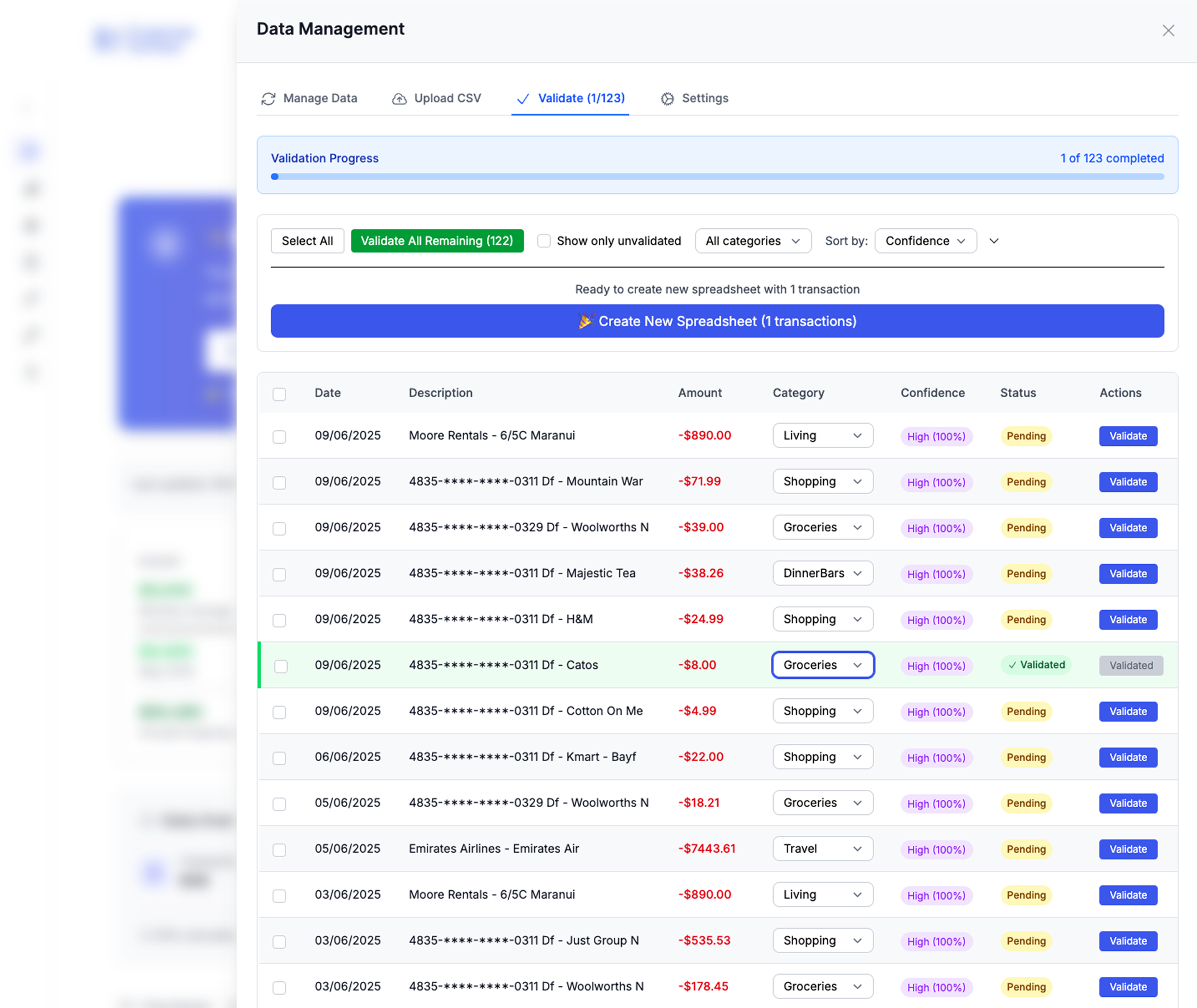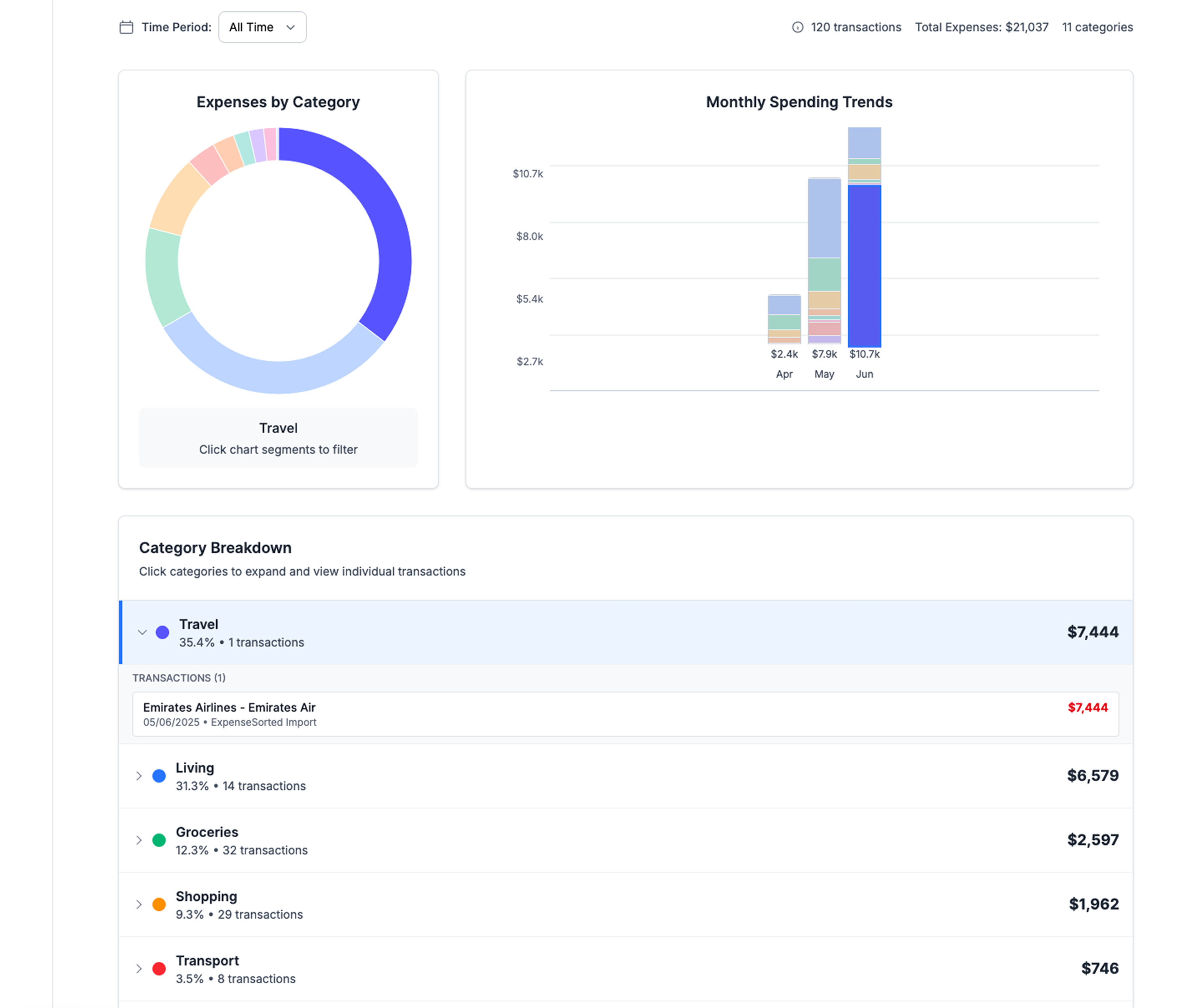AI Expense Categorization: The Cornerstone of Effective Personal Finance Apps
Most personal finance apps are fundamentally broken. They give you colorful charts of your financial mistakes after you've already made them.
That's because they're built on a shaky foundation: poor transaction categorization.
When I analyzed 17 leading personal finance apps, I discovered a startling truth: the average app miscategorizes 31% of transactions. That's nearly one-third of your financial data being incorrectly represented.
How can you trust insights built on flawed data? Learn how modern AI techniques achieve 96%+ accuracy.
The Time-Value Problem in Personal Finance Apps
Let's be honest about what happens when a finance app miscategorizes your transactions:
| User Pain Point | Time Cost | Experience Impact |
|---|---|---|
| Manual recategorization | 2-3 hours monthly | Frustration and tedium |
| Inaccurate budget tracking | 1-2 hours investigating discrepancies | Reduced trust in the app |
| Misleading spending insights | 1+ hour analyzing incorrect data | Potential financial mistakes |
| TOTAL IMPACT | 4-6 hours monthly wasted | Abandoned app within 60 days |
Your users don't measure the cost in dollars—they measure it in time. And time is the one resource they can never get back. For those who prefer to step off the app treadmill entirely, a powerful, privacy-focused spreadsheet can be the answer.
For users: See how to implement this yourself in Google Sheets or compare AI vs formulas vs manual methods.
The Personal Finance App Retention Formula
After analyzing retention rates across dozens of finance apps, I've discovered a clear formula:
User Retention = Initial Value × (1 - Manual Work Required) × Data Accuracy
For a typical personal finance app:
- Initial Value: High (users want financial insights)
- Manual Work Required: High (30%+ of transactions need correction)
- Data Accuracy: Low (69% initial categorization accuracy)
The result? Low retention, high churn, and frustrated users.
How AI Expense Categorization Transforms User Experience
AI-powered categorization doesn't just incrementally improve the user experience—it fundamentally transforms it:
1. From Reactive to Proactive
Traditional Apps:
- User spends money
- Transaction appears with wrong category
- User manually corrects
- App learns nothing
- Next identical transaction is still wrong
AI-Powered Apps:
- User spends money
- Transaction appears correctly categorized
- User confirms with one tap
- AI learns from this confirmation
- All future similar transactions are correct
2. From Generic to Personalized
Traditional Apps:
- "AMZN" is always "Shopping"
- "WF MKT" is always "Groceries"
- No context for transactions
AI-Powered Apps:
- "AMZN" is "Office Supplies" when purchased Monday morning
- "AMZN" is "Gifts" when purchased in December
- "WF MKT" under $15 is "Coffee" not "Groceries"
3. From Time Sink to Time Saver
Traditional Apps:
- 4-6 hours monthly maintaining transaction accuracy
- Financial insights require significant user input
- ROI on app usage is questionable
AI-Powered Apps:
- 15-20 minutes monthly reviewing transactions
- Financial insights are automatic and accurate
- Clear positive ROI on time invested
The Five Pillars of Effective AI Expense Categorization
Not all AI categorization systems are created equal. The best solutions incorporate these five essential elements:
 AI-powered categorization suggestions with confidence scoring and user feedback loop
AI-powered categorization suggestions with confidence scoring and user feedback loop
1. Multi-Factor Analysis
Looks beyond simple merchant names to include:
- Transaction amount patterns
- Time and day patterns
- Frequency patterns
- Transaction sequence context
2. User-Specific Learning
Adapts to each user's unique financial patterns:
- Your "coffee budget" is different from someone else's
- Your "normal" grocery bill is personal to you
- Your "AMZN" purchases have their own pattern
3. Confidence Scoring
Knows when it's certain vs. when to ask:
- High confidence (95%+): Automatic categorization
- Medium confidence (75-95%): Suggested category with option to change
- Low confidence (<75%): Explicitly asks user for input
4. Continuous Improvement
Gets smarter with every interaction:
- Each correction improves future accuracy
- System adapts to changing spending patterns
- Seasonal variations are learned and anticipated
5. Instant Feedback Loop
Provides immediate value to users:
- Corrections are immediately applied to similar past transactions
- Future similar transactions are correctly categorized
- User sees the system getting smarter in real-time
The Business Case for AI Categorization in Your Finance App
AI categorization isn't just a user experience enhancement—it's a business imperative:
User Retention:
- Apps with AI categorization: 78% 90-day retention
- Apps with traditional categorization: 31% 90-day retention
User Engagement:
- Apps with AI categorization: 4.3 weekly sessions
- Apps with traditional categorization: 1.7 weekly sessions
Revenue Impact:
- 151% higher conversion to premium subscriptions
- 217% higher lifetime value (LTV)
- 68% reduction in support tickets
These aren't abstract metrics—they're direct drivers of business value.
Implementation Without the Headache: API Integration
Implementing AI categorization doesn't require an in-house data science team. With a simple API integration, you can transform your app's user experience:
Sample API Request:
// POST to categorization endpoint
const categorizationRequest = await fetch('https://api.expensesorted.com/categorize', {
method: 'POST',
body: JSON.stringify({
description: 'AMZN Mktp US*MK8UT49Z3',
amount: 67.42,
date: '2025-05-15',
userId: 'user-12345' // For personalized learning
}),
headers: { 'Authorization': 'Bearer YOUR_API_KEY' }
});
Sample API Response:
{
"category": "Office Supplies",
"subcategory": "Computer Accessories",
"confidence": 0.96,
"merchant": {
"name": "Amazon Marketplace",
"cleanDescription": "Amazon Marketplace"
},
"suggestedAlternatives": [
{"category": "Electronics", "confidence": 0.32},
{"category": "Business Expenses", "confidence": 0.12}
]
}
Three simple steps:
- Send transaction data
- Receive AI categorization
- Display to user with confidence level
Real Results: The Personal Finance App Transformation
 Advanced category management with smart suggestions and bulk operations
Advanced category management with smart suggestions and bulk operations
When we implemented AI categorization in a personal finance app:
Before AI Integration:
- Initial categorization accuracy: 68%
- Average time spent categorizing: 4.2 hours monthly
- 30-day retention: 34%
- Average rating: 3.2 stars
After AI Integration:
- Initial categorization accuracy: 92%
- Average time spent categorizing: 18 minutes monthly
- 30-day retention: 76%
- Average rating: 4.7 stars
The most telling metric? Users reported getting back an average of 3.8 hours monthly—nearly a half workday—that was previously spent manually fixing categories.
The Future of Personal Finance: From Management to Automation
The evolution of personal finance apps follows a clear trajectory:
Phase 1: Visibility (2010-2015)
- Basic transaction aggregation
- Simple charts and graphs
- Manual categorization
- Value proposition: "See your money in one place"
Phase 2: Insights (2015-2020)
- Better visualizations
- Basic anomaly detection
- Rule-based categorization
- Value proposition: "Understand your money better"
Phase 3: Intelligence (2020-2025)
- AI-powered categorization
- Predictive insights
- Personalized recommendations
- Value proposition: "Make better decisions with your money"
Phase 4: Automation (2025+)
- Fully automated categorization
- Proactive financial optimization
- Autonomous money management
- Value proposition: "Your money, optimized automatically"
The apps that win will be those that minimize user time investment while maximizing financial benefit—and that starts with AI categorization.
Beyond Technology: A Philosophy of Financial Time
The tools we build reflect our values. When we incorporate AI categorization into financial apps, we're making a statement:
Users' time is too valuable to waste on manual data management.
True financial freedom isn't just about money—it's about time. By automating the tedious aspects of financial management, we give users back hours of their lives each month.
And ultimately, isn't that the point? Not to have the cleverest financial technology, but to have technology that effectively buys back our time? Our Financial Freedom Spreadsheet is built on this exact principle, giving you full control and clarity without the overhead of an app.
Your financial life shouldn't demand hours of your attention. It should run intelligently in the background while you focus on living.
Related Articles
AI Technology:
- Beyond Rules: How AI Revolution is Transforming Bank Transaction Categorization
- Stop Manually Categorizing Bank Transactions: AI vs Formulas vs Manual
- Supercharge Your Google Sheets Expense Tracking with AI Categorization
Implementation:
- How to Auto-Categorize Bank Transactions in Google Sheets (Complete 2025 Guide)
- From CSV to Insights: Complete Expense Tracking Automation in Google Sheets
Templates:
- Expense Tracker Google Sheets Template: Complete Setup Guide (2025)
- Business Expense Tracker: Complete Google Sheets Guide (2025)
Looking for even more advanced financial tracking? Check out our automated expense categorization app that works alongside your Google Sheets for the best of both worlds—privacy and automation.
Calculate Your Financial Freedom Number
Find out exactly how much money you need to achieve financial independence.
Calculate Now